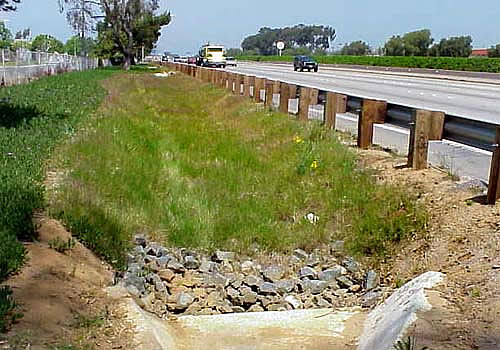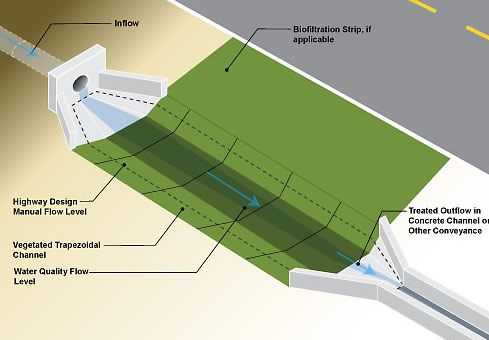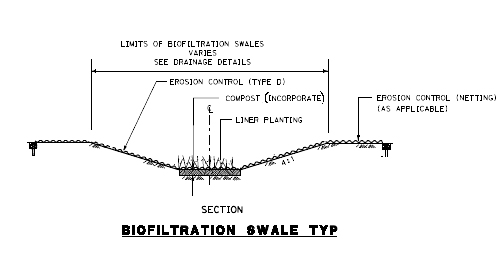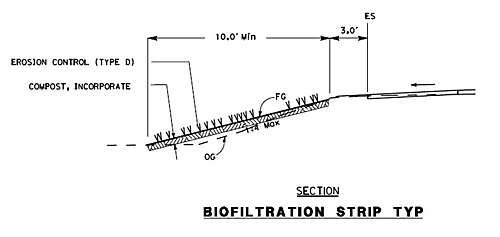Erosion Control Toolbox: Biofiltration
Introduction

This is a photo of a Biofiltration Swale.
What is This Treatment
Biofiltration Strips and Swales use plants to capture and biologically degrade pollutants carried by stormwater runoff. As an additional benefit, Biofiltration Strips and Swales reduce the velocity and volume of stormwater runoff.
Biofiltration is provided by both Biofiltration Strips and Biofiltration Swales. Biofiltration Strips, also known as vegetated buffer strips, are vegetated sections of land over which stormwater flows as sheet flow. Biofiltration Swales are vegetated channels that receive and direct the concentrated flow of stormwater.
Acceptable vegetation for Biofiltration Swales includes grasses, forbs, and ground cover.

Biofiltration Strip
Benefits
- When properly implemented, Biofiltration Strips and Swales are aesthetically pleasing. Due to vegetation, Biofiltration Strips and Swales look like a landscaped roadside, which makes these devices more acceptable than Treatment BMPs that make use of concrete-lined vaults.
- Per the BMP Retrofit Pilot Program Final Report (Caltrans, 2004) Biofiltration Strips and Swales were determined to be highly effective Treatment BMPs in reducing sediment and heavy metals and stormwater runoff volumes. They were also determined to be very cost effective and among the least expensive Treatment BMP per volume of runoff treated.
- Biofiltration Strips and Swales are well suited to being part of a “treatment-train” system of BMPs and should be considered whenever placing other BMPs that could benefit from pretreatment, especially Infiltration Basins, Infiltration Trenches, and Wet Basins.
Limitations
- Must meet maximum longitudinal slope and maximum slope requirements for Biofiltration Swales. Please refer to the the Biofiltration Swale Guidance and consult your Hydraulics Engineer.
- Vegetated Biofiltration Strips and Swales must have a minimum vegetative cover of 70% within the first full growing season.
- Vegetated Biofiltration Strips and Swales should not be used in arid regions. Instead, consider using non vegetated swales that rely upon gravel mulch or similar inert materials to protect disturbed soil areas.
- Discuss with District Design NPDES Coordinator if Strips and Swales are under consideration above contaminated soils or groundwater plumes, although the infiltration that might occur is usually considered incidental.
- Biofiltration Strips are not generally subject to the same setback restrictions as Infiltration Devices; however, if unusual geotechnical conditions exist, or if it is proposed above a retaining wall and the soils are known to be especially erodible or permeable, consult District Geotechnical Design.
- Nearby fill slopes should be observed for signs that the embankment soils are highly erodible, and the District Landscape Architect should be consulted about soil amendments, the use of fiber rolls, or other methods to reduce the erosion potential.
- Biofiltration Strips should be designed as flat as possible. For new construction, widening, or when slopes are otherwise being modified, keep slopes at 4:1 or flater for a biofiltration strip.

Specifications
Specify Biofiltration areas by combining standard Department specifications for Incorporate Materials, Compost, Hydroseed, Rolled Erosion Control Products (Netting), and Liner Plants.


Estimate Information
Biofiltration Strips and Swales are not paid for as a separate item. They are built and paid for as part of other standard items, such as Incorporate Materials, Compost and Hydroseed. Excavated material should be paid under item Ditch Excavation or Roadway Excavation depending on the bottom width per Standard Plan A62A.
Research
The ORVTS Study was implemented to assess the treatment performance of roadside slopes planted with ornamental vegetation. The ORVTS Study monitored water quality to evaluate the pollutant removal efficiency of roadside slopes planted with ornamental vegetation as opposed to the traditional use of forbs and grass species.
The Roadside Vegetated Treatment Sites (RVTS) Study (Caltrans, 2008) was a water quality monitoring project conducted by Caltrans from 2000 to 2008 to evaluate the pollutant removal efficiency of roadside slopes planted with forbs and grass vegetation. The RVTS Study results showed that roadside slopes planted with standard grasses and forbs resulted in large concentration and load reductions for several constituents of concern for highway runoff.
Updated July 9, 2018

